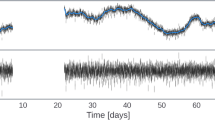Abstract
ON Saturday evening last, March 25, at about half-past nine local time, I happened to be observing some stars in the eastern quarter of the heavens, when I was astonished by the sudden appearance of a brilliant meteor with a long tail, or streamer, of a reddish hue. The colour of the ball itself was a vivid bluish white. It seemed to start from near ε Virginis, or a little to the right of that position, and to take a leisurely course in a straight line towards the north under Arcturus, α Coronæ Borealis, and ε Herculis, till I lost it behind some houses not far from the northern point of the horizon, if anything, a little to the east of that point. I was most struck with the leisurely pace at which it moved, so different from an ordinary falling star, the velocity appearing to slacken as it proceeded, like that of a railway train after it has passed a spectator. Just when passing under Arcturus, the globular head broke up, not unlike one of the fire-balls of a rocket, into a string of five or six luminous beads, getting smaller and smaller towards the tail. The entire length of the meteor seemed to be fore-shortened as it receded towards the horizon. Judging without a watch, I estimated the interval between its appearance and disappearance to be about nine seconds. At the same time a second meteor of inferior dimensions and briefer duration took a somewhat parallel course between Boötes and Ursa Major.
Similar content being viewed by others
Article PDF
Author information
Authors and Affiliations
Rights and permissions
About this article
Cite this article
SMITH, E. Splendid Meteors. Nature 3, 425 (1871). https://doi.org/10.1038/003425c0
Issue date:
DOI: https://doi.org/10.1038/003425c0



